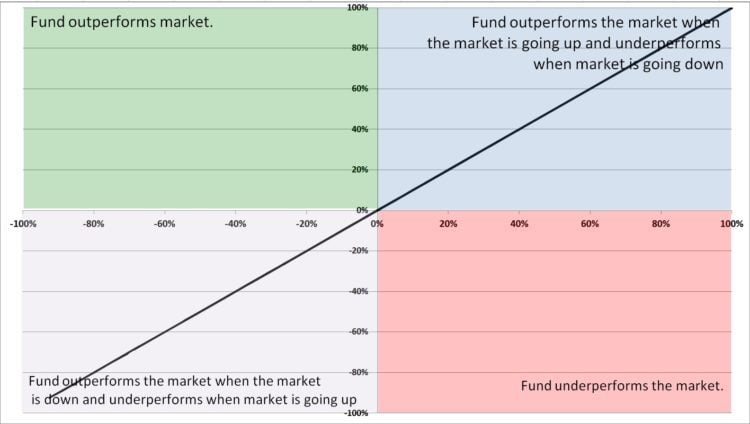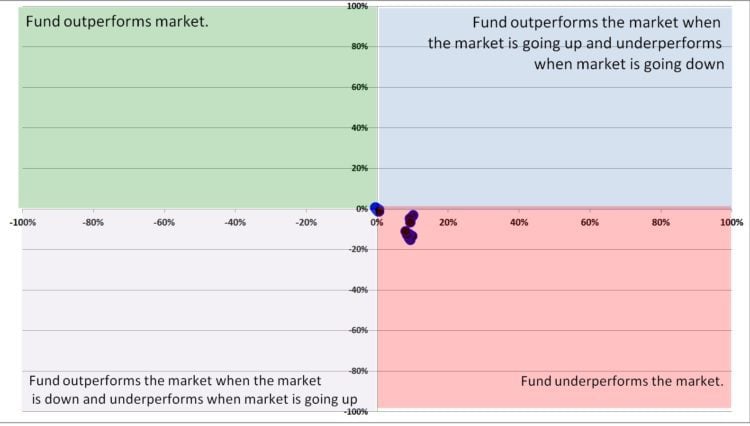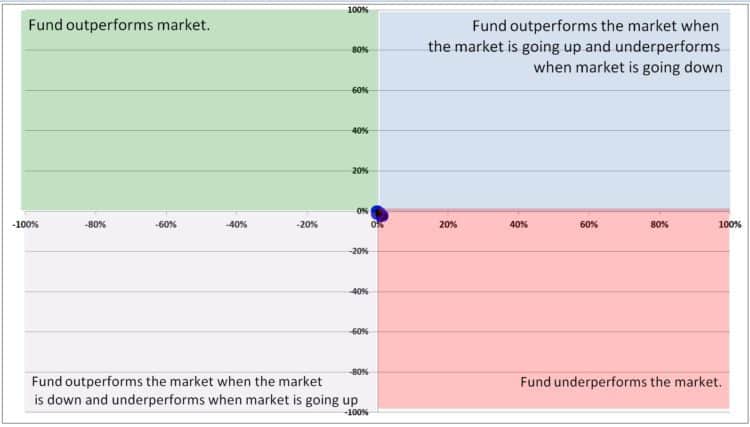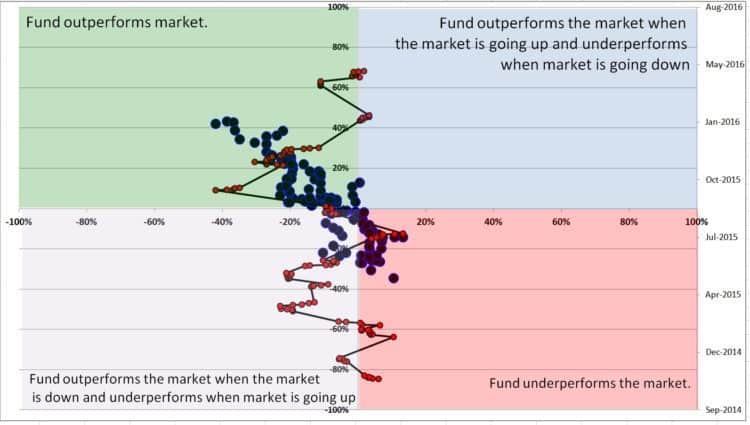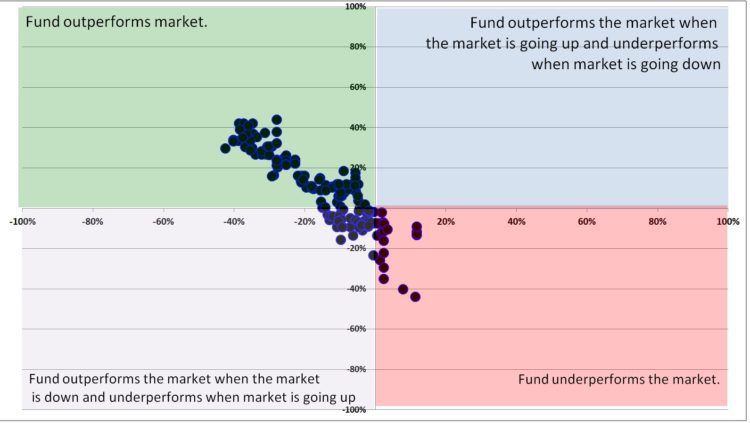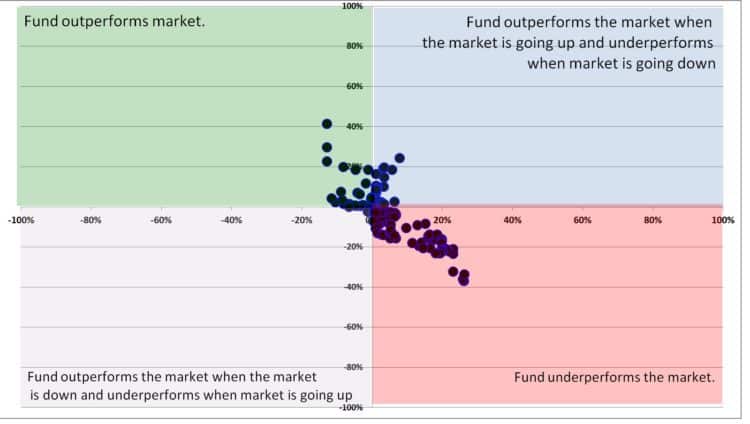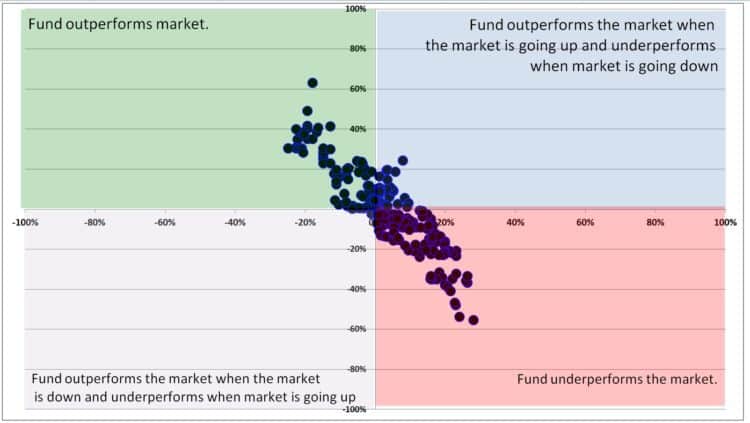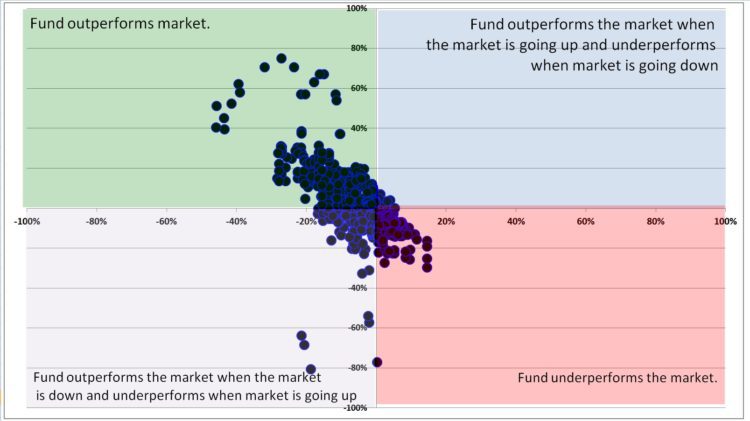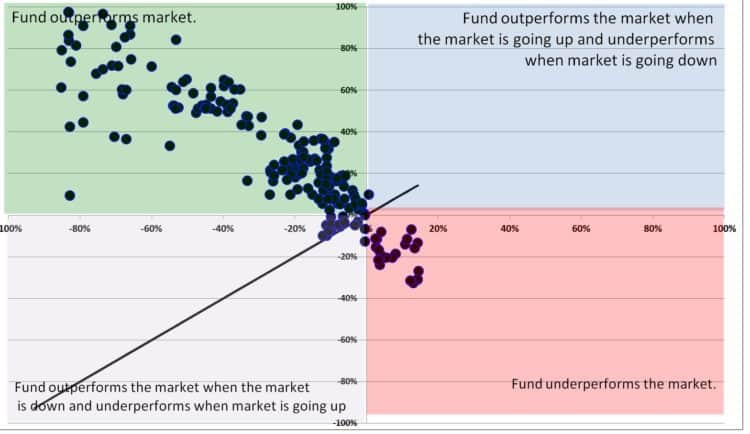Last Updated on January 10, 2023 at 9:43 pm
In this post, I describe a visual tool for analysing mutual funds and portfolios, referred to as fingerprinting by its developer,Jim Otar, a Canada-based financial planner. I thank Swapnil Kendhe for bringing this method to my attention. As the song goes, ” I get by with a little help from my friends”.
I have developed an Excel sheet to replicate the idea and having tried a few funds, I feel that this would be a very good tool for analysing individual portfolios too. More on this later. For now, let us consider individual mutual funds.
Note: As a student of the subject, posts here represent my learning (and the lack thereof). This tool or any other tool here should be used with an understanding of the nature and limitations of the inputs and therefore the outputs.
How does fingerprinting work?
Suppose I have the NAV data of a fund and its benchmark.
Join 32,000+ readers and get free money management solutions delivered to your inbox! Subscribe to get posts via email! (Link takes you to our email sign-up form)
🔥Want to create a complete financial plan? Learn goal-based investing? Exclusive access to our DIY tools? Increase your income with your skills? Use this link to enjoy massive discounts on our robo-advisory tool & courses! 🔥
1 I calculate monthly return of both
2 Find out the difference between fund return and index return when the index return was positive. Call this up-market return.
3 Do the same when the index return was negative and call it down-market return
4 Take the six-month or one-year average of up and down market returns on rolling basis
5 Plot Up-market return (Y axis) vs Down market return (X axis) to create this kind of grid.
There are now four quadrants with four different fund performances. Obviously, we want funds that have data points in the top left quadrant and bottom left quadrant.
The diagonal line is a reference which separates ‘good’/acceptable data points in the top triangle and the borderline/’bad’ data points in the bottom triangle.
In what follows, I have only considered data for the last two years. Increasing the duration will make the plots messy.
Jim Otar’s presentation on fingerprinting which is the reference for this post can be found here.
Fingerprint of an ETF
An ETF is expected to track the index as closely as possible, provided there is enough liquidity. Therefore an ETF or Index fund should have data points very close to the centre – neither too much upside nor too much downside.
This is the fingerprint of Nifty Bees with respect to Nifty TRI.
Notice the significant underperformance for a few months. This has to be due to the difference between price and NAV of the ETF. Reason: poor liquidity? In any case, the fingerprint reaffirms by belief to stay away from ETFs.
Fingerprint of an Index Fund
The above problem is not present for an index fund. This is for UTI Nifty index vs Nifty TRI.
An index fund is so much simpler than an ETF!!
Fingerprint of Quantum Long Term Equity
Quantum Long Term Equity is a multi-cap fund benchmarked against Sensex TRI. However, it can pick stocks in the BSE 200 universe. So first let look at how it fares against BSE 200 TRI.
That is not bad at all. Brief months of underperformance is expected especially with a fund that holds cash. One can track the dates of such underperformance and correlate with monthly factsheets if interested (I am not).
The date are now plotted in the right axis. The timeline increase from the bottom and zig-zags its way to the top. The Underperformance was between April to July 2015. During this period the fund also fell less than the market.
Then after Aug 2015, the fund significantly beat the index for a while. This can easily be correlated with Quantum’s cash position. Does it? Regular factsheet trackers please confirm.
Now let us see how the fund has fared against its specified benchmark: the Sensex TRI.
There is a small decrease in the underperformance.
Fingerprint of HDFC Top 200 (Direct Plan)
This is the fingerprint of HDFC Top 200 (direct plan) wrt BSE 200 TRI.
That is not a pretty picture at all! Even from Oct 1st 2006, the situation is not very different:
The problem with this fund has been: spectacular outperformance for a few months, followed by sustained underperformance. This does not mean the actual investor returns would be low. I am invested in this and my own returns have been more than okay. The fingerprint is primarily a tool to understand how a fund behaves. Whether it can use for investment decisions or not is debatable. Personally, I will not use this alone. I would prefer to use the cumulative outperformance feature in the Mutual Fund SIP XIRR Tracker.
Fingerprint of ICICI Focussed Bluechip Equity
As an example of fantastic performance here is ICICI Bluechip vs Nifty TRI.
Fingerprint of DSP Microcap (Direct Plan)
Here is how DSP Microcap (the darling of investors with theoretically high-risk appetite?) fared against BSE Small CAP TRI.
This data is for the last 3+Y since direct plans came into being and is pretty awesome!
How can this tool be used?
1. In my opinion, this can a good way to gauge investor stress visually. That is the stress associated with holding the fund. For another way of doing this visually, check the post on mutual Fund Analysis With the Ulcer Index.
2. Please do not base investment decisions only on this tool. As discussed yesterday, Good Personal Finance Questions with Arbitrary Answers!, how long a fund can underperform has an arbitrary answer.
3. Now imagine the above data with your portfolio (entire equity holdings) vs Sense or Nifty. Now that would be awesome! I am working on ways to autogenerate the graphs plotted here: Analysis: My Mutual Fund Investing Journey. Then such fingerprinting also will be possible. Fingers crossed.
4. Otar in his presentation (link above) refers to other uses, but I am not too comfortable about it.
This tool is now part of the freefincal investor circle. Join the investor circle! Enjoy a 50% discount for a limited time and pay only Rs. 3000 with discount code circle50. You can get lifetime access to several unique tools, discussion forums, and bug fixes.

Use our Robo-advisory Tool to create a complete financial plan! ⇐More than 3,000 investors and advisors use this! Use the discount code: robo25 for a 20% discount. Plan your retirement (early, normal, before, and after), as well as non-recurring financial goals (such as child education) and recurring financial goals (like holidays and appliance purchases). The tool would help anyone aged 18 to 80 plan for their retirement, as well as six other non-recurring financial goals and four recurring financial goals, with a detailed cash flow summary.
🔥You can also avail massive discounts on our courses and the freefincal investor circle! 🔥& join our community of 8000+ users!
Track your mutual funds and stock investments with this Google Sheet!
We also publish monthly equity mutual funds, debt and hybrid mutual funds, index funds, and ETF screeners, as well as momentum and low-volatility stock screeners.
You can follow our articles on Google News

We have over 1,000 videos on YouTube!

Join our WhatsApp Channel



- Do you have a comment about the above article? Reach out to us on Twitter: @freefincal or @pattufreefincal
- Have a question? Subscribe to our newsletter using the form below.
- Hit 'reply' to any email from us! We do not offer personalised investment advice. We can write a detailed article without mentioning your name if you have a generic question.
Join 32,000+ readers and get free money management solutions delivered to your inbox! Subscribe to get posts via email! (Link takes you to our email sign-up form)
About The Author
 Dr M. Pattabiraman (PhD) is the founder, managing editor and primary author of freefincal. He is an associate professor at the Indian Institute of Technology, Madras. He has over 13 years of experience publishing news analysis, research and financial product development. Connect with him via Twitter(X), LinkedIn, or YouTube. Pattabiraman has co-authored three print books: (1) You can be rich too with goal-based investing (CNBC TV18) for DIY investors. (2) Gamechanger for young earners. (3) Chinchu Gets a Superpower! for kids. He has also written seven other free e-books on various money management topics. He is a patron and co-founder of “Fee-only India,” an organisation promoting unbiased, commission-free, AUM-independent investment advice.
Dr M. Pattabiraman (PhD) is the founder, managing editor and primary author of freefincal. He is an associate professor at the Indian Institute of Technology, Madras. He has over 13 years of experience publishing news analysis, research and financial product development. Connect with him via Twitter(X), LinkedIn, or YouTube. Pattabiraman has co-authored three print books: (1) You can be rich too with goal-based investing (CNBC TV18) for DIY investors. (2) Gamechanger for young earners. (3) Chinchu Gets a Superpower! for kids. He has also written seven other free e-books on various money management topics. He is a patron and co-founder of “Fee-only India,” an organisation promoting unbiased, commission-free, AUM-independent investment advice.Our flagship course! Learn to manage your portfolio like a pro to achieve your goals regardless of market conditions! ⇐ More than 3,500 investors and advisors are part of our exclusive community! Get clarity on how to plan for your goals and achieve the necessary corpus no matter the market condition!! Watch the first lecture for free! One-time payment! No recurring fees! Life-long access to videos! Reduce fear, uncertainty and doubt while investing! Learn how to plan for your goals before and after retirement with confidence.
Increase your income by getting people to pay for your skills! ⇐ More than 800 salaried employees, entrepreneurs and financial advisors are part of our exclusive community! Learn how to get people to pay for your skills! Whether you are a professional or small business owner seeking more clients through online visibility, or a salaried individual looking for a side income or passive income, we will show you how to achieve this by showcasing your skills and building a community that trusts and pays you. (watch 1st lecture for free). One-time payment! No recurring fees! Life-long access to videos!
Our book for kids: “Chinchu Gets a Superpower!” is now available!


Must-read book even for adults! This is something that every parent should teach their kids right from their young age. The importance of money management and decision making based on their wants and needs. Very nicely written in simple terms. - Arun.Buy the book: Chinchu gets a superpower for your child!
How to profit from content writing: Our new ebook is for those interested in getting a side income via content writing. It is available at a 50% discount for Rs. 500 only!
Do you want to check if the market is overvalued or undervalued? Use our market valuation tool (it will work with any index!), or get the Tactical Buy/Sell timing tool!
We publish monthly mutual fund screeners and momentum, low-volatility stock screeners.
About freefincal & its content policy. Freefincal is a News Media organisation dedicated to providing original analysis, reports, reviews and insights on mutual funds, stocks, investing, retirement and personal finance developments. We do so without conflict of interest and bias. Follow us on Google News. Freefincal serves more than three million readers a year (5 million page views) with articles based only on factual information and detailed analysis by its authors. All statements made will be verified with credible and knowledgeable sources before publication. Freefincal does not publish paid articles, promotions, PR, satire or opinions without data. All opinions will be inferences backed by verifiable, reproducible evidence/data. Contact Information: To get in touch, please use our contact form. (Sponsored posts or paid collaborations will not be entertained.)
Connect with us on social media
- Twitter @freefincal
- Subscribe to our YouTube Videos
- Posts feed via Feedburner.
Our publications
You Can Be Rich Too with Goal-Based Investing
 Published by CNBC TV18, this book is designed to help you ask the right questions and find the correct answers. Additionally, it comes with nine online calculators, allowing you to create custom solutions tailored to your lifestyle. Get it now.
Published by CNBC TV18, this book is designed to help you ask the right questions and find the correct answers. Additionally, it comes with nine online calculators, allowing you to create custom solutions tailored to your lifestyle. Get it now.Gamechanger: Forget Startups, Join Corporate & Still Live the Rich Life You Want
 This book is designed for young earners to get their basics right from the start! It will also help you travel to exotic places at a low cost! Get it or gift it to a young earner.
This book is designed for young earners to get their basics right from the start! It will also help you travel to exotic places at a low cost! Get it or gift it to a young earner.Your Ultimate Guide to Travel
 This is an in-depth exploration of vacation planning, including finding affordable flights, budget accommodations, and practical travel tips. It also examines the benefits of travelling slowly, both financially and psychologically, with links to relevant web pages and guidance at every step. Get the PDF for Rs 300 (instant download)
This is an in-depth exploration of vacation planning, including finding affordable flights, budget accommodations, and practical travel tips. It also examines the benefits of travelling slowly, both financially and psychologically, with links to relevant web pages and guidance at every step. Get the PDF for Rs 300 (instant download)
